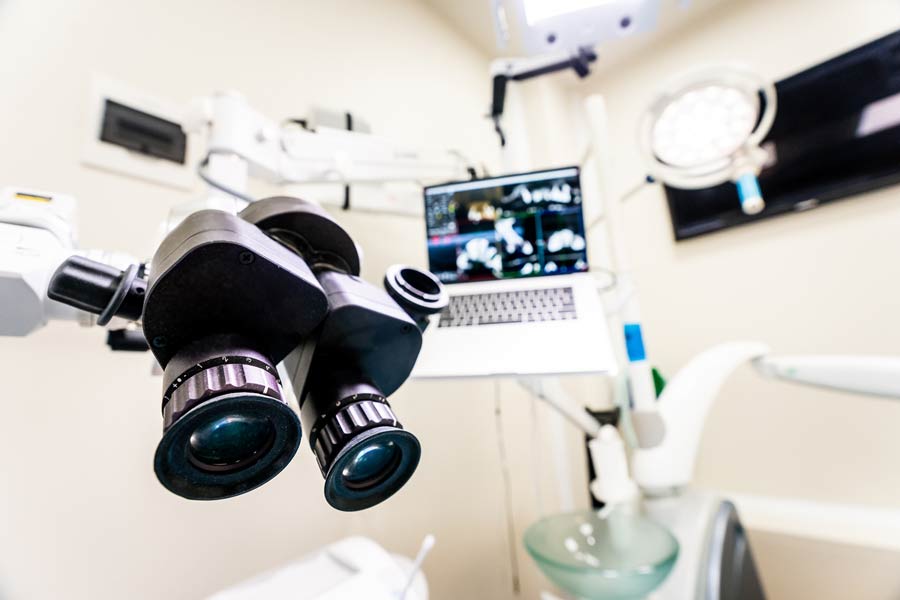

Gum Recession
Advanced treatments to improve gingival aesthetics and health.
Why Does Gum Recession Occur?
Gum recession, also known as gingival recession, occurs when the edge of the gum tissue moves back, exposing the roots of the teeth. There are several reasons why gum recession may occur:
- Periodontal disease: The main cause of gum recession is periodontal disease, especially periodontitis. Periodontitis is a chronic bacterial infection that affects the tissues surrounding and supporting the teeth.
- Aggressive tooth brushing: Aggressive tooth brushing or the use of a hard-bristled toothbrush can damage the gingival tissues and cause them to recede.
- Poor oral hygiene habits: Lack of proper oral hygiene, such as not brushing teeth regularly or not using dental floss, can contribute to the accumulation of bacterial plaque and tartar.
- Genetic factors: Some people may have a genetic predisposition to gum recession. The structure and position of the gingival tissues can be influenced by hereditary factors.
- Dental trauma: Injuries or trauma to the teeth or gums, whether from accidents, blows, or inappropriate dental procedures, can damage the gingival tissues and cause them to recede.
- Bruxism: Bruxism, which is the involuntary grinding or clenching of the teeth, can exert excessive pressure on the gingival tissues, leading to gum recession.
It is important to note that gum recession is not only an aesthetic problem but can also lead to dental sensitivity, an increased risk of root caries, and long-term dental stability issues.
If you experience gum recession, it is advisable to consult a periodontist or dentist. They will be able to assess the underlying cause of the recession and recommend the appropriate treatment, which may include measures to control periodontal disease, modify oral hygiene habits, and in some cases, perform periodontal surgery procedures to correct the recession and protect the exposed roots.
What is the Treatment for Gum Recession?
The treatment for gum recession depends on the underlying cause and the severity of the condition. Here are some common treatment options for gum recession:
- Improving oral hygiene: In many cases, gum recession is related to the buildup of bacterial plaque and poor oral hygiene habits. Improving tooth brushing technique and using dental floss properly can help prevent further recession and improve gum health. Additionally, the use of antibacterial mouthwashes can help control inflammation and reduce plaque buildup.
- Treatment of periodontal disease: If gum recession is related to periodontal disease, appropriate periodontal treatment may be necessary. This can include root scaling and planing procedures to remove bacterial plaque and tartar from the tooth roots, as well as periodontal surgery in more advanced cases.
- Gum graft surgery: In cases of more severe gum recession, where there has been significant loss of gingival tissue, a gum graft may be performed. During this procedure, tissue is taken from another area of the mouth, such as the palate, and placed in the area of recession to cover the exposed roots and improve the aesthetic appearance.
- Regenerative treatments: In some cases, tissue regeneration techniques can be used to stimulate the growth and regeneration of lost gums and bone. This may include the use of bone graft materials, growth factors, and regenerative membranes.
It is important to emphasize that treatment for gum recession should be personalized according to the specific needs and conditions of each patient. Therefore, it is advisable to consult a specialized periodontist or dentist for an accurate diagnosis and an appropriate treatment plan.
In addition to professional treatment, maintaining good oral hygiene, avoiding aggressive brushing, and having a balanced diet can help prevent gum recession and maintain good periodontal health.
Process
How is Surgery Performed to Treat Gum Recession?
A surgery to treat receding gums is known as gingival recession surgery or root coverage surgery. Below, we describe the general steps of this type of surgery:

Gum Recession Procedure:
- Local Anesthesia: Before starting the surgery, local anesthesia will be administered to numb the area and ensure that the patient is comfortable during the procedure.
- Access to the Surgical Site: The periodontal surgeon will make an incision in the gum around the affected area to expose the dental roots and the recession area.
- Debridement and Cleaning: A thorough debridement of the dental roots will be carried out to meticulously remove bacterial plaque, tartar, and other deposits. This helps prepare the roots for the next step of the procedure.
- Root Coverage Techniques: There are various techniques used to cover the exposed roots and treat receded gums. Some of the common techniques include:
- Connective Tissue Graft: In this technique, connective tissue is taken from the palate area or another source and carefully placed over the recession area to cover the exposed dental roots.
- Soft Tissue Graft: In this technique, tissue from the patient's own gums is used to cover the exposed roots.
- Membranes and Grafting Materials: In some cases, membranes or grafting materials may be used to assist in the healing process and promote the growth of new tissue in the affected area.
- Sutures: Once the root coverage technique is performed, the gum is sutured with resorbable or non-resorbable sutures to ensure proper healing and stabilization of the tissues.
- Postoperative Care Instructions: After the surgery, the periodontal surgeon will provide detailed instructions on how to properly care for the surgical area during the healing process. This may include recommendations on oral hygiene, dietary restrictions, and possible medications for pain and inflammation management.
It is important to note that each gum recession surgery may vary according to the individual needs of the patient and the technique used by the periodontal surgeon. Therefore, it is advisable to consult a periodontics specialist for an accurate evaluation of your condition and detailed information about the specific procedure to be performed.

What Gel and Mouthwash are Recommended for Receding Gums?
It's important to note that the treatment of receding gums generally involves dental procedures performed by dental professionals, such as gingival recession surgery or tissue grafts. However, in terms of oral care products that can help maintain gum health, there are gels and mouthwashes that can be beneficial.
Here are some examples:
- Chlorhexidine Gel: Chlorhexidine is an effective antimicrobial agent that can help reduce bacterial plaque and gum inflammation. It can be found in the form of gel or mouthwash. However, chlorhexidine can cause staining on the teeth over time, so it's important to follow usage instructions and consult with a dental professional before long-term use.
- Fluoride Gel or Mouthwash: Fluoride is beneficial for strengthening teeth and preventing dental caries. It can help maintain overall good dental health, including the gums. Look for oral care products that contain fluoride to help protect teeth and gums.
- Gel or Mouthwash with Anti-inflammatory Ingredients: Some gels or mouthwashes may contain anti-inflammatory ingredients, such as aloe vera or coenzyme Q10, which can help reduce gum inflammation and promote tissue healing.
It's important to note that the choice of a specific gel or mouthwash for receding gums may vary based on individual needs and recommendations. It's advisable to talk with a dentist or dental hygienist for personalized recommendations and to determine which product is most suitable for your specific situation.
In addition to using oral care products, maintaining good oral hygiene, including regular tooth brushing with a soft brush, using dental floss, and periodic visits to the dentist for a complete dental exam and professional cleanings, is essential. These measures combined with the right products can help maintain gum health.
+80%
What is the Success Rate of Treatment for Gum Recession?
In general, when appropriate treatment is performed and post-care instructions are followed, it is possible to achieve positive results and stabilize gum recession. The main goal of treatment is to stop the progression of recession and cover the exposed roots to improve aesthetic appearance and protect dental tissues.
However, it is important to note that the long-term success of gum recession treatment largely depends on maintaining proper oral hygiene and managing factors that can contribute to the recurrence of recession, such as periodontal disease or aggressive brushing.
In some more complex or advanced cases, additional or combined treatments, such as tissue grafts or bone regeneration surgeries, may be necessary to achieve the best results.
For more precise information on the success rate of a specific treatment for your particular case of gum recession, I would recommend consulting a periodontist or specialized dentist. They will be able to evaluate your clinical situation and provide a more accurate perspective on the expectations and potential success of the treatment.
What are the Benefits of Undergoing Gum Recession Treatment at ENIQ?
The use of technology in the treatment of gum recession can offer a range of benefits. Some of the benefits include:
- Precision and Predictable Results: Technology can assist dental professionals in making more accurate diagnoses and planning treatment more effectively. The use of tools such as digital imaging, computed tomography, and intraoral scanners allows for detailed imaging of the gums and teeth, facilitating the identification of the cause of recession and the design of a personalized treatment plan. This can lead to more predictable and satisfying results.
- Less Discomfort for the Patient: Technology can help to minimize discomfort during the treatment of gum recession. For example, the use of computer-guided injection technology for local anesthesia can provide more accurate anesthesia and reduce the sensation of pain or discomfort during the procedure. Additionally, some treatment techniques, such as the use of dental lasers, can be less invasive and more comfortable for the patient compared to conventional methods.
- Faster Recovery Times: Some technologies used in the treatment of gum recession can accelerate the healing process and reduce recovery times. For instance, the use of dental lasers can help to minimize bleeding and trauma to the tissues, which can lead to quicker recovery and less postoperative discomfort.
- Aesthetic Improvement: Technology can play an important role in the aesthetic enhancement of gum recession treatment. For example, digital planning and simulation of results can help visualize how the gums will look after treatment, allowing for greater precision in correcting the shape and contour of the gums to achieve an optimal aesthetic result.
- Increased Efficiency and Productivity: Some technologies, such as surgical navigation systems or specialized instruments, can assist dental professionals in performing procedures more efficiently and accurately. This can allow for more efficient use of time, reduction in treatment duration, and improvement in overall productivity.
It is important to note that the incorporation of technology in the treatment of gum recession can vary depending on the professional and the dental clinic. Not all clinics may have access to the same technologies. If you are interested in receiving gum recession treatment with technology, I would recommend seeking a specialized periodontist or dentist who is up-to-date with the latest techniques and technologies available in the field.
What is the Price of the Treatment for Gum Recession?
The cost of periodontal access surgery without bone regeneration is €410 per quadrant of the mouth.
In cases where bone grafting with Emdogain is indicated, the amount is €635, also per quadrant.
Although this price may seem high, in reality, the surgery is the most economical alternative for the patient, as it offers the possibility of saving their own tooth. Otherwise, they would lose it, and even if they wanted to get an implant, the cost for oral health would be much higher, as they would not keep their original dental piece.
Periodontics
Oral Health
*subject to specialist assessment
Discover our specialized service in the treatment of gum recession. We offer you a guarantee of effective and professional treatments to improve the health and aesthetics of your gums.
-
All-Inclusive
Frequently Asked Questions
Do you have more questions about gum recession treatment?
Most treatments are performed with local anesthesia to minimize discomfort. After the procedure, it is normal to experience some sensitivity or discomfort, which generally subsides within a few days.
Not always. The need for a gum graft depends on the severity and underlying cause. In less severe cases, other treatment approaches may be effective.
The recovery time varies depending on the type of treatment. Generally, you can expect some temporary sensitivity and discomfort which typically improves within a few days.
In some cases, particularly in early stages, gum recession can be reversed with proper treatment and ongoing oral health management.
Services
All rights reserved © ENIQ Clinic 2025
Legal Notice · Privacy Policy · Cookie Policy
